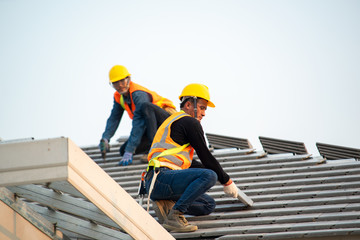What You Need to Know About Roof Installation

A new roof can be a great way to improve your home’s curb appeal. But installing a new roof is a big job, so it’s important to understand what you’re getting into before the work starts.

Roofing contractors are responsible for installing the roof of a house or other structure. Their responsibilities include removing damaged shingles and installing new ones, asphalt, and insulation to create a waterproof seal. Roofing Contractors are trained to handle different types of roofing systems, and they also know to resolve unexpected problems.
The roof consists of rafters or trusses (wood members that support the house’s decking), sheathing, and shingles. In addition, it needs ventilation and a drip edge to protect the underside of the roof from rain and snow.
Choosing the right materials for your roof installation can make all the difference in how it functions and looks. They can protect your property from weather elements, enhance its curb appeal, improve its energy efficiency, and fit your budget. Roofing materials have different benefits and disadvantages, so it’s important to research the options thoroughly before making a decision. It’s also important to understand how long they last and how much maintenance they require.
The climate where you live plays an important role in selecting the best material for your home. For example, if your area is known for heavy rains, choose a material that can withstand such conditions. Another factor to consider is the weight of different materials. If a material is too heavy, it can affect the structure of your home.
Ultimately, you should choose the materials that complement the structural components of your home and not overburden it with excess weight. Over time, this can lead to damage, which may result in expensive repairs.
If you’re planning to install a new roof, you should definitely get a permit. This is because a permit protects homeowners in a number of ways. For one, it helps ensure that you’re working with a licensed contractor. A licensed contractor will know how to use standard safe practices, and they’ll be insured should any accidents occur on site.
Permits also keep contractors honest by preventing them from cutting corners and ignoring codes. This is especially important in construction, as it prevents workers from putting together unlicensed or substandard work.
It’s always a good idea to check with your city or county to see what permits are required for your roof installation. This way, you’ll be able to plan your project in advance and make sure all of your construction is compliant with local codes. It’ll also save you a lot of time and frustration later on! This is especially true if you’re planning to sell your home.
Removing the old roof is one of the most important and crucial steps in a roof replacement. It is the only way to properly prepare your roof for installation.
It is also the only way to prevent future problems. By removing the old roof, your contractor can find leaks, damaged flashing, rotted wood and other potential issues that could become costly and difficult to fix in the future.
The crew will unroll protective tarps to protect foundation plantings, shrubs and other areas around the home. They will then use magnetic tools to pick up nails and other objects that can damage your lawn or shrubs.
A new roof can have a positive impact on your home. It can help promote safety, prevent health hazards, and save you money on heating and cooling bills.
In addition to these benefits, a new roof can improve your home’s value. Upon resale, the National Association of Realtors estimates that owners can recoup over half of the cost of a roof replacement.
A new roof is a major project, so it’s important to work with a professional roofing company to get the job done right. A qualified contractor will be able to guide you through the entire process, from choosing the right materials to the final day of installation.
